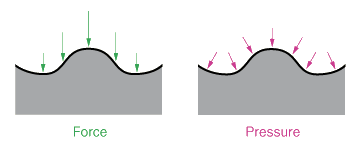Pressures | |
| |
A pressure definition consists of two components:
- Transmission surface
- Magnitude
The pressure magnitude is specified in units of force per area; this magnitude is applied
normal to the transmission surface at every point on the surface. Unlike a force, which
always acts in a single direction, a pressure is applied normal to all regions of a
surface during the entire simulation, regardless of the surface curvature. 
Pressures typically represent the forces exerted by a gas on the walls of a container, such as air in a balloon. However, a pressure load can also be used to model any evenly distributed force across an area, such as the contact forces between two closely fitting, conforming parts.
You can define the following types of pressures:
| Pressure | Description |
|---|---|
| Uniform value |
One value is used throughout the model. |
| Hydrostatic |
A linear pressure distribution is defined by specifying a zero pressure height and a reference pressure magnitude and height. This load definition is available only in Abaqus/Standard. |
| Mapped spatial data |
A mapping table defines the value at each location, with a separate value for all areas outside the mapped region. |
| User-defined |
A DLOAD/VDLOAD user subroutine linked to the analysis case defines the pressure. |